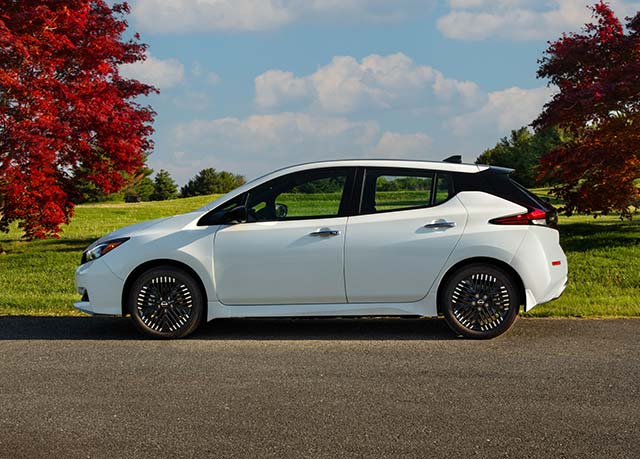Vermont
Arrowhead Ciderworks and Vermont Cider Lab Scale Up and Open Bars in Chittenden County

When it comes to Thanksgiving tipples, cider is top tier. The fermented apple-based beverage screams fall flavors and goes perfectly with cranberry sauce, stuffing and turkey. It also has more range than most drinkers realize — from bubbly and sweet to still and dry, and just about everything in between.
Two home cidermakers in Chittenden County recognized the drink’s potential, making the leap from basement and closet to commercial production facilities and bars over the past few years. Ahead of our favorite food holiday, we headed out to sample their ciders and stock up.
— J.B.
Hair of the Dog
Vermont Cider Lab, 25 Essex Way, Suite 214, Essex, 876-7702, vtciderlab.com
Apple varieties such as Ashmead’s Kernel, Hubbardston Nonesuch, Sheep’s Nose and Westfield-Seek-No-Further give cidermakers plenty to work with when it comes to naming their products. But at Vermont Cider Lab, co-owners Chris Line and Karen Wisehart rely on a different fruitful collection of monikers: dog nicknames.
The Essex Junction couple’s flagship ciders are Bubba, Cassa Frass and Stinker; seasonal flavors include Smelvis, Sloaner and Willow Willow. All are named after dogs they’ve had or known over the years. The logo depicts their current pup, Kurri — the yellow Lab behind the “Lab.”
Inside the cans with catchy canine names are dry ciders fermented with local maple syrup or honey, made on-site at the Essex Experience. They’re served — along with cider cocktails, slushies, hot toddies and snacks — in a 50-seat tasting room in the former Christopher & Banks outlet between Magic Mann and the Mad Taco. (There’s also a 24-seat, dog-friendly seasonal patio.)
Line began making cider in his basement 14 years ago, tinkering with five-gallon batches on equipment his father had started using “way, way back,” he said. Over the years, the former strength coach shared batches with his clients who worked in the beverage industry, looking for feedback.
“When the pandemic hit, just like everybody, we hit control-alt-delete to figure out what we really wanted to be doing,” Line said, metaphorically referring to the reboot command on a computer.
Wisehart had long wanted to own a wine shop of her own. Meanwhile, she’d become a regular at the Essex Experience’s Salt & Bubbles Wine Bar and Market and was inspired by owner Kayla Silver’s work to get that business up and running.
“Karen came home from there one day and said, ‘Why don’t we see if we can make this cider thing work?’” Line recalled.
The couple headed out to cideries around Vermont to check out tasting rooms and introduce themselves. The welcoming response they received from big players such as Stowe Cider and Eden Ciders “made us want to do it even more, to be a part of that community,” Wisehart said.
They sought out former Eden director of operations Garrett Huber, who now runs a cidery in Ohio and works as a craft cider consultant, for help scaling Line’s five-gallon basement batches to 250-gallon batches in the Lab’s brand-new production space. Four months in, Line is “asking fewer questions, now that I’m doing it on a daily basis,” he said.
And Line’s doing everything, from fermenting juice sourced from Waterbury Center’s Cold Hollow Cider Mill to canning and self-distributing. He estimates that he’ll produce close to 5,500 gallons of cider this year. Wisehart, who still works full time as general manager of South Burlington’s Best Western Plus Windjammer Inn & Conference Center, handles marketing and other behind-the-scenes tasks. She also joins Line in the taproom after work and on weekends.
Distribution wasn’t in the couple’s immediate plans, but they’ve already expanded to local retailers and restaurants, including the Windjammer. They purchased their own canning line and now send kegs and 16-ounce cans to businesses as close as Black Flannel Brewing & Distilling in Essex and as far as Farmhouse Market in Wilmington.
All of the Lab’s ciders are dry, with zero added sugar. “But not everybody has a dry palate,” Line said. To give folks a sweeter option, the tasting room offers cider-based takes on classic cocktails, including cider mules, cideritas, cider Bee’s Knees and cider slushies — the latter are available hard, with an added shot of booze, or nonalcoholic.
The cocktails help “bridge the gap” for folks who are new to cider or think they don’t like it, Line said. “We want to give them different avenues to try it out,” he continued. “Cider is a pretty diverse, versatile beverage.”
The cider Bee’s Knees ($12) was a standout of my recent Sunday visit, when a group of friends and I sampled the Lab’s cider in various forms. Created for Bee’s Knees Week in late September, the balanced, fragrant cocktail features the Stinker cranberry cider, Barr Hill Gin, honey-based simple syrup and lemon juice, garnished with a sprig of thyme. It was my friend’s order, but I kept stealing sips.
I opted for a sample flight of the Lab’s ciders ($12) to try as many as possible: the traditional dry Bubba, the cranberry Stinker, the blueberry-basil Sloaner and the ginger-lemon Cassa Frass. Each was worthy of a full pour, which I rarely find with flights.
They all paired well with the array of snacks we ordered: a Vermont cheese plate ($15), soft pretzels ($12 for two) and a savory Gobbler pocket pie from Underhill’s Poorhouse Pies.
On top of making all the cider and driving around distributing it, Line heads to Poorhouse every day to pick up whichever pies and quiches are in stock.
“You have to be versatile,” Line said of his do-it-all approach. “I’m learning every day, but it’s never something I don’t want to learn.”
— J.B.
Beverage Bull’s-Eye
Arrowhead Lodge, 2 River St., Milton, 891-6359, arrowheadlodgevt.com and @arrowheadciderworks on Instagram. Note: Arrowhead will be closed for Thanksgiving from November 22 to 27.
Lauren and Nick Mark never intended to become bar owners. But serendipity has played a big role in the lives of the co-owners of the Arrowhead Lodge taproom in Milton and its sister business, Arrowhead Ciderworks.
The couple met by chance a decade ago at a coffee shop in lower Manhattan. Nick, now 36, was in the city for the weekend. He hails from western Connecticut but was then living on Martha’s Vineyard and working as an architectural drafter. Lauren, now 34, grew up in Rochester, N.Y., and had recently moved to New York City to pursue a career in modern dance.
Nick bought Lauren coffee, and the happenstance encounter led to bigger things. Earlier this year, the now-married couple welcomed their son, Ronin. And a few years before that, they had their “first baby,” as Lauren playfully described their bar and cider businesses.
First, though, the couple moved to Milton in 2018. Lauren became the office manager for the Vermont Brewers Association, a job that immersed her in the craft alcoholic beverage market. Nick worked in construction and developed a serious hobby of making hard cider in the closet of their apartment. The couple liked cider but didn’t care for the sweetness of many brands.
The Marks became friends with the couple who owned and were renovating the 1840s brick building just off the intersection of Route 7 and Main Street, across from their apartment. “We’d bring beers over and sit on Home Depot buckets and talk,” Lauren said.
The first floor of the building was zoned for commercial use, and their friends encouraged the Marks to do something with it. They explored the possibility of turning Nick’s hobby into a business and building a cidery there, but wastewater permitting issues wouldn’t allow it.
The Marks still wanted to create something in the historic building. It had housed several different bars, so they figured they’d try a new watering hole — though with a different flavor. (One of their customers has since recounted a story of being thrown through the front window of a previous bar there.)
The couple wanted to create a community gathering spot with game and trivia nights, book club gatherings, and seasonal music on an outdoor deck. They named their new bar Arrowhead, referring to the nearby lake and mountain. While there are no overnight accommodations, they chose the word “lodge” because it’s “cozy,” Lauren said.
Arrowhead Lodge opened in February 2020. After a rough start due to the pandemic, the business has become the community center the Marks envisioned. There’s a 100-person wait list for its “mug club” — devoted locals who pay a $100 annual membership fee for some discounts, quarterly members-only events and a personal mug cubby. Six months ago, the couple bought the building.
The Marks started serving Arrowhead Ciderworks’ Cloud Cap — a clean, crisp, bone-dry, unfiltered cider — at their taproom in March 2021. They now produce about 1,000 gallons annually from freshly pressed Vermont apples in partnership with local alcohol production facilities, where they ferment and can the flagship cider. Cloud Cap is sold on tap and in cans at a growing number of northern Vermont retailers, restaurants and bars.
Nick said he appreciates that a dry cider can be “a blank canvas” for added flavors. Before Christmas, he plans to launch a second cider: Cloud Hop, which features Chinook and Centennial hops grown by Starksboro’s Champlain Valley Hops. He is also working on a semisweet cider, one fermented with sake yeast and one made with Chinese gunpowder tea — his wife’s favorite, she said.
On a recent Thursday evening, a steady stream of customers came through the door of Arrowhead Lodge and settled in with a cider (from $7 for 12 ounces) or their choice of a list of mostly Vermont beers (from $3 for 8 ounces).
Even though Lauren knew exactly what she wanted to offer on the tap and can list, she said the beer distributor rep was initially skeptical of her focus on craft beer and cider in a spot where Budweiser had flowed. “He said, ‘You’ll never make it in this town,’” she recalled.
But locals have welcomed Arrowhead Lodge. Milton residents Cassidy Tedeschi and her boyfriend, Josh “Boomer” Patterson, were perched at the bar sipping Troc Star from Eden Ciders in Newport and a Candy Bar Gunner’s Daughter beer from Maine’s Mast Landing Brewing, respectively. Nick, who was working the bar, greeted them and most customers by name.
“Someone always walks in that we know, or we meet new people, or we can talk to Nick all night,” Tedeschi said.
The bar lacks a TV. “We want people to talk to each other,” Nick said.
A limited food menu includes popcorn ($3 or $4 with Old Bay seasoning), a Vermont meat and cheese board ($19), pizzas ($12 to $15) made by Vermont Pie & Pasta in Derby, and whoopie pies ($3) baked at the Painted Lady Café in Milton. Painted Lady will soon provide weekly hot specials, such as pulled pork mac and cheese, chicken and dumplings, and chili.
Tedeschi and Patterson visit Arrowhead often enough that they decided to join the mug club; they finally got in after a year on the wait list.
“Everybody wants to be in the mug club,” Patterson said.
— M.P.

Vermont
Weird & Wacky Electric Car Deals For Those Who Live In Vermont Or Colorado – CleanTechnica

Sign up for daily news updates from CleanTechnica on email. Or follow us on Google News!
Electric cars are too expensive, some people say. Well, that may be true in some cases, especially if a customer wants a pickup truck with a big battery like a Rivian or Ford F-150 Lightning. However, for a lucky few, the price of admission to the world of electric car mobility may be substantially lower, if they happen to live in Vermont or Colorado.
Vermont has become one of the most proactive states in America when it comes to addressing the onrushing climate crisis. That’s because it has been ravaged time and time again by floods that have caused massive destruction. The Green Mountain State, unsurprisingly, has a lot of green mountains, and in between those mountains are steep valleys. Under normal conditions, when it rains in Vermont, the water runs down into those valleys and into Vermont’s rivers, which carry the water away in due course to destinations further south.
The problem is, over the past ten years or so, Vermont has experienced heavier than normal rains on a regular basis, rains so heavy that they have overwhelmed the cities and towns in the valleys below. Often, those rains are from the tail end of hurricanes that move northward, dumping their cargo of moisture as they go. A decade ago, Bill McKibben was home in Vermont when one such hurricane devastated his hometown. He wrote about how rising temperatures in the atmosphere contribute to those heavier rainfall events in his book Oil And Honey way back in 2013.
The mechanics of the problem are really quite simple. Warmer air holds more moisture than cooler air. More moisture means heavier rain. What is not so simple is reducing the human activity that increases the average temperature of the atmosphere — burning fossil fuels. One of the consequences of the floods Vermont has been experiencing lately — including earlier this year when the remnants of Hurricane Beryl dumped six inches of rain on the state in a matter of a few hours — is a sharp increase in the number of flood-damaged vehicles. Cars don’t react well to being underwater, so many of those cars have to be scrapped.
Vermont Expands Electric Car Incentives
Vermont already has one of the most aggressive programs to help residents switch to electric cars. Called Replace Your Ride, it provides up to $6,000 to EV buyers, but there is an added bonus. If the buyer trades in an existing gasoline- or diesel-powered car, there is a sweetener of an additional $5,000. Combined with a federal tax credit of up to $7,500, that allows Vermonters to knock a total of $18,500 off the price of an electric car, but there was a catch until recently.
To qualify for the $5,000 incentive for trading in a conventional car, that vehicle had to be at least 10 years old, in working condition, and currently registered and inspected. But because of the number of flood-damaged cars after Hurricane Beryl, the cars no longer need to be 10 years old. The state now says, “For Vermonters impacted by the 2024 flood events, vehicles totaled by the flooding may be scrapped, regardless of age.” The vehicles don’t have to be in working condition or even able to start, Kelley Blue Book reports.
If you want to buy a used electric car instead of a new one? Vermont still has attractive purchase incentives for those customers as well. The new car bonus doesn’t apply, of course, but the $5,000 for scrapping a flood-damaged car still does, plus low-income Vermonters may qualify for an additional $5,000 bonus when they buy a used electric car. Combine that with the federal used EV tax credit of $4,000 and the total comes to $14,000. The federal credit only applies to cars priced at $25,000 or less, so if all the criteria are met, a low-income Vermonter could be parking a $25,000 used electric car in the driveway for just $11,000.
Colorado Dealer Offers $19 A Month Lease On New Nissan LEAF
Colorado is another state that is offering aggressive incentives to people who decide to switch to an electric car. The state has adopted a number of strategies to slash its carbon emissions by 2030. Since emissions from the transportation sector are a major contributor to the state’s total emissions, Colorado has put a number of strategies in place to help get cars and trucks with lower emissions on its roads.
Those strategies are working. In the second quarter of 2024, registrations of battery electric vehicles rebounded to 16 percent of all vehicle registrations after a slight dip in the beginning of the year, according to a report from the Colorado Auto Dealers Association. Over the first half of 2024, the total electric car market share in the first half of 2024 is up nearly 5 percent from a year earlier.
Tynan’s Nissan, a dealership in Aurora, Colorado, is offering a 24 month lease on a Nissan LEAF for $19 per month after taxes and dealer fees. The customer must pay about $2,400 in sales taxes and dealer fees up front, but then the Colorado incentives plus an incentive from Xcel Energy can provide up to $8,100 in benefits. In a lease, that amount is applied to the value of the lease, not the total price of the car. “That is definitely a contributing factor to why you can get such inexpensive leases,” Matthew Groves, the CEO of the Colorado Auto Dealers Association, told Colorado Public Radio. “The flexibility is something that does not exist in other states, and that has largely been a product of our cooperation between the industry and the government.”
The $19 a month lease at Tynan’s Nissan is for a base model LEAF, which has a range of only 149 miles and the now outmoded CHAdeMO charging standard. That car may not be the first choice of many drivers, but may be ideal for some, especially when the cost of motoring is less than what a golf cart would cost.
The EV lease deal went viral online after a YouTube channel featured the special in early July, kicking off a wave of coverage on auto blogs and TikTok accounts. 184 customers have since taken advantage of the offer and 117 are waiting for more cars to arrive at the dealership. Because the Colorado electric car incentives enable dealers to structure bargains around publicly funded discounts, a wave of cheap lease deals on battery-powered cars has popped up across the state. As a result, Colorado now competes with Washington for the second highest EV market share after California. In response, carmakers and dealers have pumped cars into the state, increasing supply and cutting vehicle costs.
One of the benefits of such low-cost leases is that they allow drivers who might not otherwise try an electric car to experiment with the new technology for very little money. Perhaps they will enjoy the experience so much that when the lease is up, they will remain in the electric car camp. In that respect, these leases could prove to be a gateway to the electric car future for some Colorado drivers.
The Takeaway
What we can learn from this is that policies matter. The Nissan LEAF is enjoying a bit of a moment in Colorado because of those policies, while in Florida, Nissan dealers often don’t even mention them on their websites. Both Vermont and Colorado have dedicated themselves to policies designed to lower their carbon emissions, while many of their sister states are thumbing their noses at the specter of global heating because they prefer ideology over science. Soon we will see which strategy is better.
Have a tip for CleanTechnica? Want to advertise? Want to suggest a guest for our CleanTech Talk podcast? Contact us here.
Latest CleanTechnica.TV Videos
CleanTechnica uses affiliate links. See our policy here.
CleanTechnica’s Comment Policy
Vermont
How a Vermont game warden got a bear out of the attic at a Stowe condominium

A bear got stuck in the attic of a Stowe condo looking for bird seed.
Game Warden Jeremy Schmid responded to a call from Stowe Police concerning a bear in the attic of a Stowe condo complex. A bird feeder was to blame.
Provided by Vermont Fish & Wildlife Department.
On July 16, Game Warden Jeremy Schmid got a call from the Stowe Police Department saying a bear had climbed a two-story deck at a condominium development near downtown and now found itself in the attic. Oh boy.
This was a new one for Schmid, even though he’s on the frontlines of human/bear conflicts in the Underhill patrol district he covers, which includes towns from Bolton to Cambridge, as well as Chittenden County and Grand Isle County when he’s needed. Game wardens, like many professions, are in short supply.
Unfortunately, bear invasions of homes are on the rise in Vermont. Jaclyn Comeau, the Vermont Fish & Wildlife Department’s lead bear biologist, said in an email there have been at least 30 successful and attempted home entries by bears this year in Vermont. Ten years ago, Comeau said, there were only one to four reports a year.
Bear in the attic
When he arrived on the scene in Stowe, Schmid talked to the police officers, who confirmed the bear was still in the attic. Schmid consulted maintenance workers at the condominium to get the layout of the attic, which was empty, with only rafters and trusses and blown insulation − no people. Schmid had police evacuate the top two condo units where the bear was, as well as a neighboring unit.
“I ended up going into the attic via the condo unit where the bear was,” Schmid said.
Peeking into the pitch black attic with his flashlight, Schmid saw the bear in question lying down, facing away from him, next to the hole it had climbed through. He judged the bear to be about 175 pounds, a mature adult, based on how far apart its ears were. Schmid had no way of knowing whether the bear was male or female.
“It was warm in that attic, over 100 degrees,” Schmid said.
Schmid’s first idea was to hit the bear with a non-lethal rubber wildlife defense round, hoping it would climb down the opening it had used to reach the attic.
“That was not the case,” he said. “It ran across the attic, did a small loop and came back to where it was. I was 15 yards from it. It looked right at me.”
When all else fails, bang on the ceiling with your flashlight
Time for Plan B. Schmid decided to go into the condo directly below the bear and try to encourage it to come down by making its entrance hole larger to create an inviting exit hole.
“I was about to do it when I could hear the bear right above me, breathing,” Schmid said. “I decided not to do that.”
Instead Schmid began banging on the ceiling of the condo with his flashlight, directly below where he knew the bear was.
“I could hear it move around, getting restless,” Schmid said. “I backed up and saw paws come through the ceiling.”
That’s when Schmid started filming his video from behind the closed sliding doors of the condo. He had two maintenance people with him and told them not to move.
“Bears have keen eyesight,” Schmid said. “Us being below, even though we were inside it may have not come down.”
As the bear continued to descend, Schmid went out on the deck to make sure it got all the way to the ground. He had two Stowe police officers keeping everyone away. Once the bear hit the ground, Schmid hit it with another non-lethal rubber wildlife defense round to make sure it returned to the woods.
Of course it was a bird feeder that caused the whole mess
Why was the bear in the attic? Schmid said a bird feeder hanging from the deck ceiling was to blame, as is so often the case. Bears love bird seed and will go to great lengths to get it. Obviously.
“My thoughts on why it went into the attic are that it couldn’t comfortably reach the bird feeder from the railing so it climbed into the attic to reach down to the feeder,” Schmid said. “The feeder had gotten knocked down. I never saw it, to be honest. I learned from homeowners it was there. It was empty, supposedly.”
After the bear had safely retreated to the woods, Schmid met with maintenance workers and “folks that run the place,” to advise them to make sure all garbage and compost was secured, that everyone was locking their doors and windows, and that all bird feeders were secured and put away.
“Obviously that incident and video shows the extent of what a bear will do to gain access to a food source,” Schmid said. “My day to day is dealing with nuisance bears. The majority of these problems are human-induced, whether it’s not securing your garbage, not securing your compost, or feeding birds or other wildlife. It takes the community, and the state as a whole, to come together to try to mitigate this problem. These are all human-induced problems.”
Contact Dan D’Ambrosio at 660-1841 or ddambrosio@freepressmedia.com. Follow him on Twitter @DanDambrosioVT.
Vermont
Man, 23, arrested in connection to murder of his 82-year-old Vermont neighbor

A 23-year-old man faces a murder charge after police found his 82-year-old neighbor dead.
Darren Martell was charged on Thursday with aggravated murder in connection to the killing of Roberta Martin, according to NECN. Martell had been living next door to the victim in Enosburgh, Vermont.
Family reported Martin missing on July 17 after they went to her home to check on her, and she was not there.
Vermont State Police said Sunday that troopers found human remains in the woods near Martin’s home. An autopsy confirmed they were the 82-year-old woman, according to the report.
Police have yet to detail how the woman died.


According to the Saint Albans Messenger, authorities believe Martell broke into Martin’s residence and sexually assaulted the victim before killing her.
When her family arrived at the home, they found the air conditioning pulled out from the window and still running.
Martell was charged on Thursday while being held in jail. He had been in custody since Monday when he was arrested on a charge of lewd and lascivious conduct after police reportedly found him touching himself along the edge of a walking path near a school, according to NECN.
If convicted, Martell faces life in prison.
-

 World1 week ago
World1 week agoOne dead after car crashes into restaurant in Paris
-

 Midwest1 week ago
Midwest1 week agoMichigan rep posts video response to Stephen Colbert's joke about his RNC speech: 'Touché'
-

 News1 week ago
News1 week agoVideo: Young Republicans on Why Their Party Isn’t Reaching Gen Z (And What They Can Do About It)
-

 News1 week ago
News1 week agoRNC speakers want to separate the president from the person to show softer side of Trump
-

 Politics1 week ago
Politics1 week agoFox News Politics: The Call is Coming from Inside the House
-

 News1 week ago
News1 week agoVideo: J.D. Vance Accepts Vice-Presidential Nomination
-

 Movie Reviews1 week ago
Movie Reviews1 week agoFilm Review: 'Oddity' is a Little Chiller That Shows a Lot of Atmospheric Promise – Awards Radar
-

 World1 week ago
World1 week agoTrump to take RNC stage for first speech since assassination attempt





:quality(70)/cloudfront-us-east-1.images.arcpublishing.com/cmg/RDBEBFPKE5GFLCOH4ILCXMFSTQ.jpg)



:quality(70)/cloudfront-us-east-1.images.arcpublishing.com/cmg/7GWN4IUJVJHH7GKKITNXHLNNP4.jpeg)














